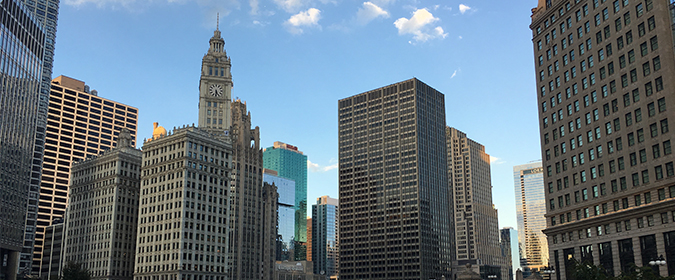“Architecture is the art with which we live,” according to Blair Kamin, the architecture critic for the Chicago Tribune. CRE.Converge 2017 attendees enjoyed a unique view of the many developments that form the Chicago skyline during an architectural river project tour of Chicago sponsored by the Wisconsin Economic Development Corporation.
Tour guide Mary Ludgin, Ph.D., Managing Director and Director of Global Investment Research at Heitman, is a longtime docent for the Chicago Architecture Foundation and was previously an urban planner for the City of Chicago. She addressed the history, architecture and development of the city throughout the tour.
In the 1800s, development in Chicago concentrated on access to the railroad. Some areas of the city with proximity to the railroad lines that have been dormant for 40 years are now seeing a resurgence in activity, said Ludgin. The Chicago fire of 1871, paradoxically, also provided a reset of sorts for the city.
“Despite the fire’s devastation, much of Chicago’s physical infrastructure, including its transportation systems, remained intact,” according to History.com. “Reconstruction efforts began quickly and spurred great economic development and population growth, as architects laid the foundation for a modern city featuring the world’s first skyscrapers.”
There’s a fair amount of available square feet in Chicago, and as JLL points out in their Chicago 2025: Dynamic Expansion report, “The steady stream of major corporations following the migration of educated millennials and top talent toward downtown has brought a new era of development across all property types.” A state historical preservation tax credit helps some older buildings endure among the modern architecture dotting the riverfront.
Also of note for Chicago development: The outside weather, fair or foul, does little to deter Chicagoans from getting where they need to go. “Chicagoans are a hardy bunch – they would be walking along outside if it were snowing horizontally,” Ludgin said.
Referring to elegant building design elements drawn from Parisian style among others, Ludgin quoted Daniel Burnham, American architect and urban designer, and director of works for the World’s Columbian Exposition in Chicago: “Make no little plans. They have no magic to stir men’s blood.”
Chicago Development Highlights:
LondonHouse Chicago, a 1920s office building converted into a hotel, it was awarded the Richard H. Driehaus Preservation Award for Adaptive Use. As the award announcement stated: “The project entailed the restoration and conversion of the London Guarantee and Accident Building — an exemplary, 1923 Beaux-Arts skyscraper designed by Alfred Alschuler — and the construction of a new, slender infill tower constructed on an adjacent site. The combined buildings serve as a 452-key hotel. On this iconic site along the Chicago River, this adaptive use introduced a new function for what was previously a struggling office building.”
River Point Plaza at 444 West Lake St., a Hines office development. Boasting spectacular design and views and located where the main branch of the Chicago River meets the North and South branches, it’s proof of the notion that “being near the train is a big driver of office decisions in the last 10 years,” Ludgin said.
150 N. Riverside, known by its address, was developed by John O’Donnell, CEO of Riverside Investment & Development and was honored as NAIOP Chicago’s 2016 Office Development of the Year. The project is noteworthy for its design and features railroad on one side and a public park on the other. The building narrows like a wine glass; “a dramatic entry into the Chicago skyline,” said Ludgin.
Riverline: A mixed-use development with residential on former railroad land. “When completed, it will contain 452 apartment units, an amenity deck, and a 230-vehicle parking garage,” reports Curbed.
 This post is brought to you by JLL, the social media and conference blog sponsor of NAIOP’s CRE.Converge 2017. Learn more about JLL at www.us.jll.com or www.jll.ca.
This post is brought to you by JLL, the social media and conference blog sponsor of NAIOP’s CRE.Converge 2017. Learn more about JLL at www.us.jll.com or www.jll.ca.














